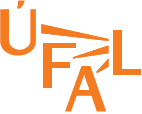Differences
This shows you the differences between two versions of the page.
| Both sides previous revision Previous revision Next revision | Previous revision Next revision Both sides next revision | ||
|
external:tectomt:tutorial [2009/01/20 16:59] popel |
external:tectomt:tutorial [2009/01/20 17:43] popel |
||
|---|---|---|---|
| Line 103: | Line 103: | ||
| There are also other directories for other purpose blocks, for example blocks which only print out some information go to '' | There are also other directories for other purpose blocks, for example blocks which only print out some information go to '' | ||
| + | |||
| Line 111: | Line 112: | ||
| ===== First application ===== | ===== First application ===== | ||
| - | Once you have TectoMT installed on your machine, you can find this tutorial in '' | + | Once you have TectoMT installed on your machine, you can find this tutorial in '' |
| - | Most applications are defined in Makefiles, which describe sequence of blocks to be applied on our data. In our particular '' | + | Most applications are defined in Makefiles, which describe sequence of blocks to be applied on our data. In our particular '' |
| We can run the application: | We can run the application: | ||
| Line 121: | Line 122: | ||
| </ | </ | ||
| - | Our plain text data '' | + | Our plain text data '' |
| - | * One physical file corresponds to one document. | + | * One physical |
| * A document consists of a sequence of bundles (''< | * A document consists of a sequence of bundles (''< | ||
| * Each bundle contains tree shaped sentence representations on various linguistic layers. In our example '' | * Each bundle contains tree shaped sentence representations on various linguistic layers. In our example '' | ||
| * Trees are formed by nodes and edges. Attributes can be attached only to nodes. Edge's attributes must be equivalently stored as the lower node's attributes. Tree's attributes must be stored as attributes of the root node. | * Trees are formed by nodes and edges. Attributes can be attached only to nodes. Edge's attributes must be equivalently stored as the lower node's attributes. Tree's attributes must be stored as attributes of the root node. | ||
| + | |||
| Line 148: | Line 150: | ||
| ===== Changing the scenario ===== | ===== Changing the scenario ===== | ||
| - | We'll now add syntax analysis to our scenario by adding four more blocks. Instead of | + | We'll now add a syntax analysis |
| <code bash> | <code bash> | ||
| Line 156: | Line 158: | ||
| SEnglishW_to_SEnglishM:: | SEnglishW_to_SEnglishM:: | ||
| SEnglishW_to_SEnglishM:: | SEnglishW_to_SEnglishM:: | ||
| - | SEnglishW_to_SEnglishM:: | + | SEnglishW_to_SEnglishM:: |
| + | | ||
| </ | </ | ||
| Line 167: | Line 170: | ||
| SEnglishW_to_SEnglishM:: | SEnglishW_to_SEnglishM:: | ||
| SEnglishW_to_SEnglishM:: | SEnglishW_to_SEnglishM:: | ||
| - | SEnglishW_to_SEnglishM:: | + | SEnglishW_to_SEnglishM:: |
| SEnglishM_to_SEnglishA:: | SEnglishM_to_SEnglishA:: | ||
| SEnglishM_to_SEnglishA:: | SEnglishM_to_SEnglishA:: | ||
| - | SEnglishM_to_SEnglishA:: | + | SEnglishM_to_SEnglishA:: |
| + | | ||
| </ | </ | ||
